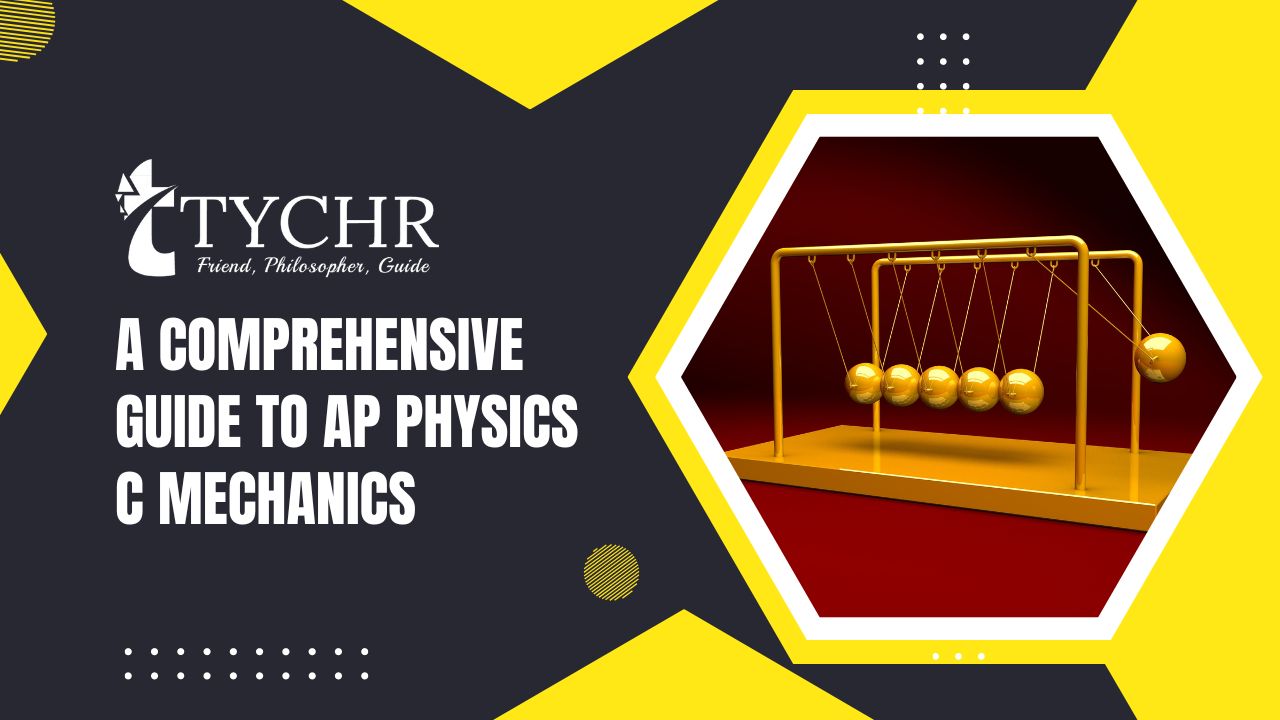Table of Contents
About AP Physics C Mechanics
AP Physics C Mechanics is an advanced course in physics that is designed for high school students who have already completed a course in physics and calculus. The course covers advanced topics in classical mechanics, such as kinematics, dynamics, work, energy, and power, as well as circular motion, rotation, oscillations, and gravitation.
The course is typically taken by high school juniors or seniors who have a strong interest in science or engineering. It is designed to prepare students for the exam, which is administered by the College Board and is typically taken in May of each year.
In this comprehensive guide, we will cover everything you need to know about AP Physics C Mechanics, including the college options, course curriculum, exam format, study tips and why you need to take it.
Why AP Physics C Mechanics?
Taking AP Physics Mechanics C can have several benefits for students who are interested in pursuing a career in STEM fields or related disciplines. Here are some reasons why you should consider taking this subject:
- College Credit: Many colleges and universities offer credit or advanced placement for students who perform well on the AP Physics Mechanics C exam. This can help students save time and money by allowing them to skip introductory-level courses and move on to more advanced coursework.
- Strong Foundation: It provides a strong foundation in physics mechanics, which is essential for understanding many concepts in engineering, physics, and related fields.
- Problem-Solving Skills: AP Physics Mechanics C emphasizes problem-solving skills and the ability to apply physics principles to real-world scenarios. These skills are valuable for a wide range of careers, from engineering to finance.
- High-Level Thinking: AP Physics Mechanics C requires students to think critically and analytically, which can help them develop higher-level thinking skills that are useful for problem-solving in many areas of life.
- Career Opportunities: Students who excel in AP Physics Mechanics C may be well-prepared for careers in engineering, physics, computer science, or other STEM fields. These are high-demand fields with strong job growth and good earning potential.
Overall, taking this can be a valuable experience for students who are interested in STEM fields or related disciplines. It provides a solid foundation in physics mechanics and problem-solving skills that can prepare students for a wide range of career opportunities.
College Options
Choosing AP Physics C Mechanics can lead to a variety of college and career options, particularly in fields related to science and engineering. Here are some of the potential paths you can take:
- Science and Engineering Degrees: A strong foundation in physics can be beneficial for those pursuing degrees in science and engineering, such as physics, mechanical engineering, aerospace engineering, or electrical engineering.
- Medical Degrees: A strong foundation in physics can be beneficial for those pursuing degrees in the medical field, such as medical physics, radiology, or radiation therapy.
- Research: Those with a background in physics can also pursue careers in research, such as in government agencies or private research firms.
- Technology: A background in physics can also be beneficial for those pursuing careers in technology, such as computer programming or software development.
The AP Physics C Mechanics course is designed for students who have already completed a course in physics and calculus. It is typically taken by high school juniors or seniors who have a strong interest in science or engineering. The course covers advanced topics in classical mechanics, such as kinematics, dynamics, work, energy, and power, as well as circular motion, rotation, oscillations, and gravitation.
To be successful in AP Physics C Mechanics, students should have a strong foundation in physics and calculus. Prior completion of an introductory physics course is recommended, as well as a solid understanding of algebra and trigonometry. Strong problem-solving skills are also necessary, as the course requires the ability to apply physics concepts to real-world scenarios.
Also Read: A Comprehensive Guide to AP Computer Science A
Course Curriculum
AP Physics C Mechanics covers the following topics:
- Kinematics: Kinematics is the study of motion without considering its causes. This includes topics like position, velocity, acceleration, and displacement.
- Dynamics: Dynamics is the study of the causes of motion. This includes topics like force, mass, acceleration, momentum, and energy.
- Work, Energy, and Power: Work is the amount of energy transferred when a force is applied to an object, and the object moves. Energy is the ability to do work, and power is the rate at which work is done.
- Systems of Particles and Linear Momentum: This includes the study of the motion of systems of particles, including collisions.
- Circular Motion and Rotation: This includes the study of circular motion and rotational motion.
- Oscillations and Gravitation: This includes the study of simple harmonic motion, gravitation, and Kepler’s laws of planetary motion.

Exam Format
The AP Physics C Mechanics exam is designed to test your understanding of advanced topics in classical mechanics, such as kinematics, dynamics, etc. The multiple-choice section is 45 minutes long and is worth 50% of your overall score; it consists of 35 questions. The free-response section is 1 hour and 30 minutes long and is worth 50% of your overall score; it consists of three problems that are designed to test your ability to apply physics concepts to real-world scenarios. The exam is scored on a scale of 1-5, with a score of 3 or higher considered passing.
The multiple-choice section tests students’ knowledge of physics concepts, while the free-response section tests students’ ability to apply those concepts to real-world scenarios. The free-response section includes one experimental design question, one short-answer question, and one long-answer question.
Here is a breakdown of the topics covered on the AP Physics C Mechanics exam and their weightage in the multiple-choice and free-response sections:
- Kinematics (5-7%): This topic covers the study of motion without considering the forces that cause the motion. It includes concepts such as position, displacement, velocity, and acceleration. Kinematics is typically tested in both the multiple-choice and free-response sections.
- Dynamics (12-18%): This topic covers the study of motion in the presence of forces. It includes concepts such as force, momentum, impulse, and Newton’s laws of motion. Dynamics is typically tested in both the multiple-choice and free-response sections.
- Work, Energy, and Power (20-26%): This topic covers the study of the relationship between work and energy, as well as the rate at which work is done (power). It includes concepts such as kinetic energy, potential energy, and the work-energy theorem. Work, energy, and power are typically tested in both the multiple-choice and free-response sections.
- Circular Motion and Rotation (10-14%): This topic covers the study of motion in a circular path and the rotation of objects. It includes concepts such as angular displacement, angular velocity, and torque. Circular motion and rotation are typically tested in both the multiple-choice and free-response sections.
- Oscillations and Gravitation (10-14%): This topic covers the study of periodic motion and the force of gravity. It includes concepts such as simple harmonic motion, pendulum motion, and Kepler’s laws of planetary motion. Oscillations and gravitation are typically tested in both the multiple-choice and free-response sections.
- Differential Equations (3-7%): This topic covers the use of differential equations to model and solve problems in physics. Differential equations are typically tested in the free-response section.
Study Tips
Preparing for the AP Physics C Mechanics exam requires a lot of dedication and hard work. Here are some study tips to help you succeed:
- Understand the AP Physics C Mechanics Curriculum: The AP Physics C Mechanics exam focuses on topics such as kinematics, Newton’s laws of motion, work and energy, rotational motion, and gravitation. Make sure you understand the specific topics covered on the exam and prioritize your study accordingly.
- Know the Calculus Requirements: AP Physics C Mechanics is a calculus-based course, and the exam will require you to use calculus concepts to solve problems. Review topics like derivatives, integrals, and differential equations, and practice applying them to physics problems.
- Solve Free-Response Questions: The AP Physics C Mechanics exam has both multiple-choice and free-response questions. To succeed on the exam, you need to be able to solve complex problems and explain your reasoning clearly. Practice solving free-response questions from previous exams to prepare.
- Understand the Relationship Between Equations: Physics equations are interrelated and build on each other. Make sure you understand how different equations are derived and how they relate to each other. This will help you solve more complex problems and avoid making mistakes.
- Pay Attention to Units: Units play a crucial role in physics, and you will need to be able to convert between units and use them correctly in equations. Practice unit conversions and pay close attention to units in your calculations.
- Use Calculators and Formulas Wisely: While calculators and formulas can be helpful, they can also be a hindrance if you rely on them too heavily. Practice using your calculator efficiently and memorize key formulas so that you can solve problems more quickly.
- Review Lab Experiments: The AP Physics C Mechanics exam includes a laboratory component, and you will need to be able to design and perform experiments, analyze data, and draw conclusions. Review your lab experiments and make sure you understand the scientific method and experimental design.
Conclusion
AP Physics C Mechanics is a challenging but rewarding course that can help prepare you for a career in science or engineering. To succeed in this course, it is important to review the basics, practice regularly, and utilize online resources and study groups. The exam format includes multiple-choice and free-response sections, and students must have a solid understanding of physics concepts to pass. With the right resources and approach, you can master the content and excel on the AP Physics C Mechanics exam.








